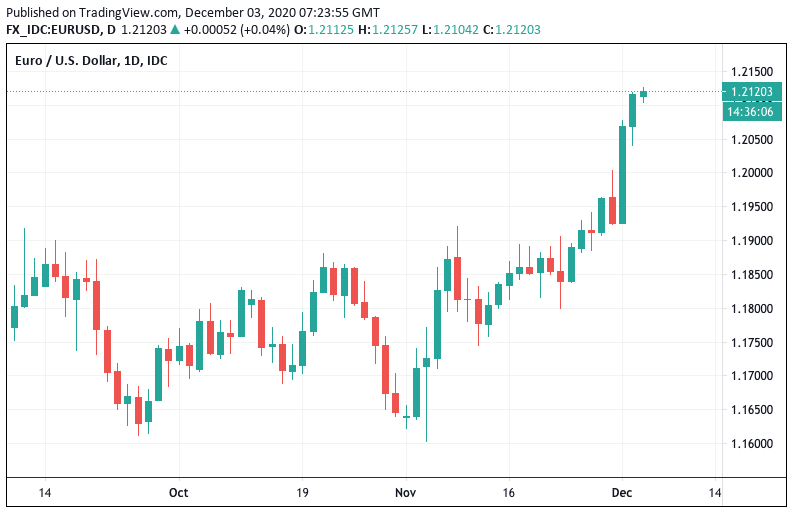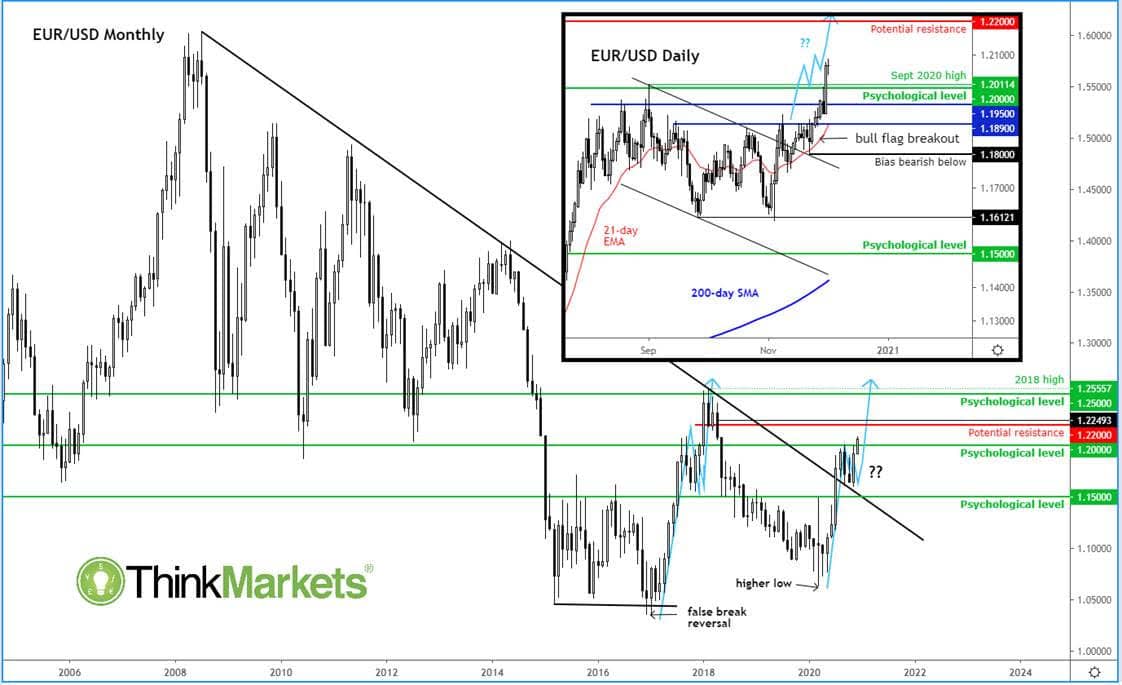Euro-Dollar Forecast: "Possibility that the Exchange Rate could be Heading to 1.25+" says ThinkMarkets

Image © Adobe Images
Fawad Razaqzada, Market Analyst at ThingMarkets, tells us where the Euro-Dollar exchange rate could be headed next, now that it has broken through the 1.20 barrier:
After teasing both the bulls and the bear for several weeks, the EUR/USD finally staged a breakout above its recent highs and the 1.20 handle on Tuesday.
The next question is where rates will head to over the coming weeks, with the ECB’s policy decision looming large on December 10 when the central bank is widely expected to expand its QE programme.
Above: The breakout in the euro-to-dollar exchange rate extends into Thursday as 1.21 is breached.
In normal circumstances, lowering interest rates or expanding QE would mean lower bond yields for Eurozone, which in turn would translate to a lower exchange rate as investors move funds into currencies where the monetary policy is comparatively tighter.
But these are not normal times and the FX markets across the world have been responding very different to norm in reaction to central bank action.
Whenever a major central bank loosened it policy this year, the country’s stock market benefited as you would expect.
Yet, paradoxically, the local currency also benefited at the same time. Part of the reason for this is because interest rates are already at or near zero across the major developed economies, so carry trade advantage does not exist – unless you invest in a high risk economies such as Turkey where base rates are 15% currently.
The other reason is that since March, it has all been about “risk on” or “risk off” trade and investors have largely ignored data and central bank decisions.
Taking the above into consideration and assuming normalcy will return to Europe with the development of vaccines, the ECB’s likely decision to boost QE in a couple of weeks’ time should be good news for European stock markets, and therefore other risk assets, including – dare I say – the euro.
That’s how investors see the euro at the moment, for otherwise rates should have fallen. I see no reason for that to change, which is why I maintain a medium-term bullish view on the single currency.
Meanwhile, from a technical point of view, the path of least resistance is clearly to the upside for the EUR/USD until the charts tell us otherwise.
Dips back to old resistance levels should therefore be supported. One such level is the area around 1.2000 now, formerly a key resistance zone on the daily time frame (inset). Below here, the next line of defence for the bulls come in around 1.1950, followed by 1.2890:
As things stand, any pullback from these levels should be seen as a retracement rather than trend reversal – until there is a breakdown in market structure of higher highs and higher lows. The most recent low is at 1.1800 as shown on the daily chart.
This is now the line in the sand for me.
Should rates break below 1.1800 then that would be a bearish development in my view.
In terms of resistance, the next hurdles are the round numbers such as 1.21 and 1.22, with the latter also being the point of the origin of the breakdown from April 2018.
But as the monthly chart shows, there is a possibility that the exchange rate could be heading to 1.25+ in the coming weeks.
This is because price looks to be following the script of 2017 as illustrated on the weekly time frame. In 2017 rates surged higher then consolidated for a while around the 1.20 handle before extending sharply higher. Since the low was formed this March, we are seeing a similar pattern in 2020. First, the rally, then the consolidation, and now the extended rally?
If you have any questions, a colleague who wants to be added to the list or you no longer wish to receive market updates from me, please do not hesitate to get in touch!






